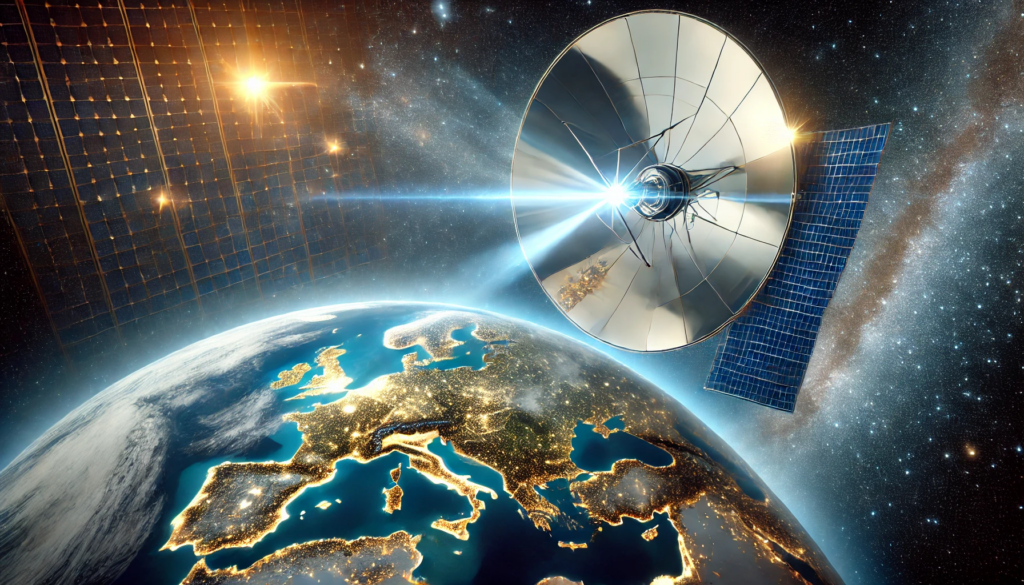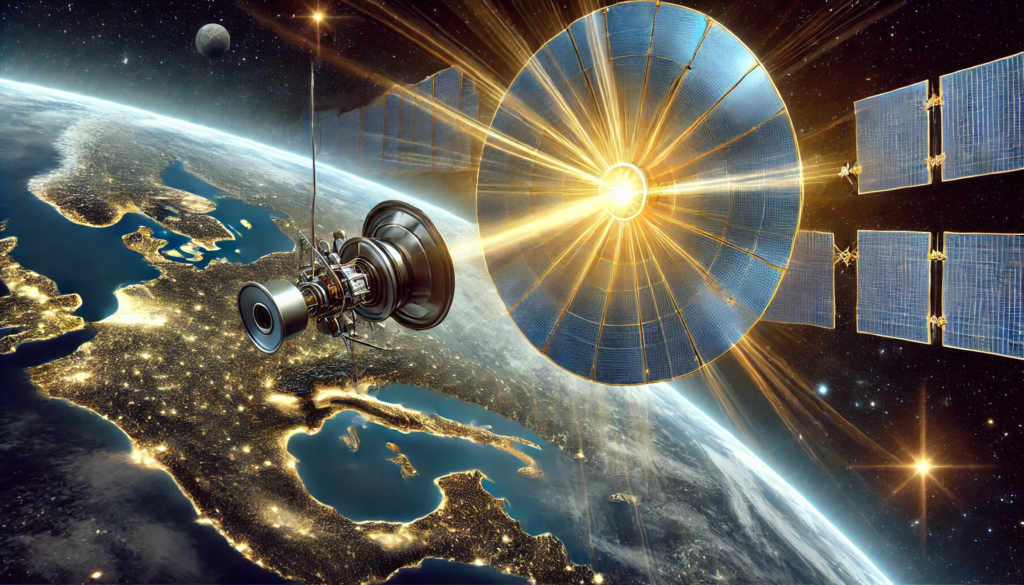
ChatGPT:
Summary of the Article
In the early 1990s, Russian engineer Vladimir Syromiatnikov spearheaded an ambitious plan to illuminate dark regions on Earth by reflecting sunlight from orbit. Although the idea of a giant space mirror dates back to the 1920s—when rocket pioneer Hermann Oberth first proposed using large orbital reflectors for navigation and potential disaster relief—it gained renewed traction under Syromiatnikov’s Znamya (“banner”) project. His goal: extend daylight in Siberia’s harsh winters and potentially lower energy costs.
Znamya 2 (1993):
• Syromiatnikov attached a 20m-wide aluminized Mylar mirror to an unmanned Progress spacecraft and launched it to the Mir space station.
• On 4 February 1993, the mirror briefly unfurled in orbit, creating a small, moving patch of light over parts of Europe.
• Though it proved less bright and harder to control than expected, the test demonstrated that the concept could work, at least technically.
Znamya 2.5 (1999):
• Building on the initial success, Syromiatnikov developed a larger 25m mirror intended to reflect light five to ten times brighter than the full moon.
• Deployed from another Progress craft, the mirror unfortunately became entangled in an antenna and tore, ending the experiment.
With the Znamya 2.5 failure, funding dried up, halting plans to build an even bigger 70m reflector (Znamya 3) and eventually an array of orbital mirrors. Syromiatnikov, a storied Soviet engineer known for designing key spacecraft docking systems, died in 2006 without seeing his dream of solar sails and permanent space mirrors fully realized. Despite its short-lived success, the Znamya project stands as a notable example of visionary—if controversial—space engineering.

Below is a broad, multidisciplinary look at the merits and challenges of deploying giant space mirrors like the Znamya project. We’ll consider perspectives from various scientific and societal fields, including aerospace engineering, astronomy, ecology, economics, and social sciences.
- Aerospace Engineering
Merits
• Proof of Concept for Solar Sails: The Znamya project demonstrated that extremely thin reflective material can be unfurled in orbit to harness solar radiation. This technology could be repurposed for propelling spacecraft via solar sails, potentially reducing fuel requirements.
• In-orbit Assembly & Deployment: Znamya highlighted techniques for assembling or deploying large structures in microgravity. The experience gained could inform future missions that require sizable, lightweight components (e.g., space telescopes or solar power stations).
Challenges
• Structural Complexity: Maintaining a perfectly smooth mirror surface in microgravity is difficult. Wrinkles or tears can severely degrade performance.
• Orbital Stability & Control: Keeping an enormous reflective surface correctly oriented to reflect sunlight onto a specific region requires precise attitude control, especially given aerodynamic drag (even in low Earth orbit) and gravitational perturbations.
• Launch & Maintenance Costs: Large structures demand multiple launches, complex deployment mechanisms, and ongoing servicing, all of which are expensive.
- Astronomy and Astrophysics
Merits
• Research on Reflective Materials: Advances in lightweight reflective films can benefit other space instruments, such as solar observatories or large space telescopes.
Challenges
• Light Pollution: Astronomers worry that an intensely bright object passing across the sky can wash out faint celestial objects, complicating ground-based observations.
• Observation Interference: Bright flashes or streaks from giant mirrors in orbit can interfere with astronomical imaging and time-series data, making it harder to detect phenomena like distant supernovae or asteroid transits.
- Environmental and Ecological Science
Merits
• Potential Energy Savings: If successfully directed, reflected sunlight might reduce electricity usage in areas with limited winter daylight, possibly lowering fossil-fuel consumption for lighting or heating in those regions.
• Disaster Relief or Agriculture: In theory, space mirrors could provide emergency illumination for rescue operations or extend agricultural work hours in remote areas.
Challenges
• Disruption of Circadian Rhythms: Organisms—from humans to plants and animals—rely on natural light/dark cycles. Artificially extending daylight could disrupt wildlife behaviors, breeding cycles, and plant growth.
• Climate Implications: While localized brightening might be helpful, unintended consequences for local weather, temperature, or ecological balance are not well understood.
• Resource Allocation: Reflecting sunlight is energy “neutral” in a global sense (no net increase in solar energy), but local, intense illumination could create microclimate changes.
- Economics and Energy Policy
Merits
• Reduced Lighting Costs: In theory, bright regions of reflected sunlight could lessen the electricity costs for Arctic or remote locations.
• Resource for Solar Power: Mirrors in orbit could focus additional sunlight onto ground-based solar farms, boosting power generation.
Challenges
• High Upfront Investment: Launch, construction, and maintenance costs are enormous, calling into question whether the net savings in energy bills could ever offset initial expenses.
• Risk of Project Failure: As seen with Znamya 2.5, a single mishap can doom a mission and sink substantial investment.
• Opportunity Cost: Funds might be more effectively directed toward terrestrial renewables, energy storage, or efficiency measures.
- Social and Human Factors
Merits
• Extended Working Hours and Comfort: In regions enduring prolonged winter darkness (e.g., Arctic latitudes), extra light could improve mental health, productivity, and general well-being.
• Symbolic and Inspirational Value: Ambitious space projects often capture the public imagination and can drive innovation, international collaboration, and enthusiasm for science.
Challenges
• Cultural and Ethical Considerations: Many communities adapt culturally to seasonal changes in daylight. Artificial illumination from orbit raises questions about potential disruption of traditions or local lifestyles.
• Light Inequities: Deciding which regions get priority for illumination could become politicized. Some parts of the world might feel overlooked, while others gain advantages.
- Broader Technological and Ethical Implications
• Technological Spin-Offs: New materials and engineering methods can be developed for ultra-thin, reflective, and durable surfaces under harsh orbital conditions.
• Ethical Risks of Weaponization: Historically, space mirror concepts have been tied to “death rays” or climate manipulation scenarios. Large orbiting reflectors could be perceived as threats, raising geopolitical tensions.
• Regulatory Hurdles: International treaties and laws may need updating to address large-scale sunlight reflection and its global impacts.
Conclusion
The Russian Znamya project underscored both the visionary appeal and the formidable practical hurdles of illuminating Earth from space. While there are tantalizing potential benefits—such as improved quality of life in dark polar regions, innovative propulsion methods, and possible energy savings—these must be weighed against significant technical, ecological, economic, and societal challenges. Any future revival of the space mirror concept will need robust international collaboration, thorough risk-benefit analyses, and technological advancements to surmount the difficulties that halted the Znamya experiments.

Here are several potential reasons why large-scale orbital mirror projects like Znamya have not continued or been adopted by other space agencies and organizations:
- High Costs and Uncertain Return on Investment
• Launch and Development Costs: Designing and deploying a massive orbiting mirror is extremely expensive. It requires specialized materials, multiple launches, and ongoing operational support.
• Unclear Economic Benefits: The anticipated savings on electrical bills or possible agricultural benefits have not been convincingly demonstrated to outweigh the high upfront and maintenance costs.
• Greater ROI from Other Technologies: Funding agencies often favor more proven or immediately beneficial technologies, such as advanced Earth-based renewables, energy storage, and efficiency measures. - Technical and Engineering Challenges
• Complex Deployment: Ensuring a perfectly shaped, tensioned, and oriented reflective surface in microgravity is difficult. Even minor tears or wrinkles substantially reduce the mirror’s efficiency.
• Attitude Control and Stability: Large reflective structures are sensitive to solar radiation pressure, drag (albeit small in low Earth orbit), and other perturbations. Maintaining a steady “beam” is technically intricate.
• Risk of Catastrophic Failure: As shown by Znamya 2.5, a single mishap (like entangling in an antenna) can destroy the mirror and end the mission. - Environmental and Astronomical Concerns
• Light Pollution: Astronomers worry that intense reflected light would disrupt nighttime observations, degrade data quality, and create artificial brightness in the night sky.
• Impact on Ecosystems: Constant or additional light could confuse migratory species, disrupt breeding cycles, and affect plant growth patterns.
• Ethical and Regulatory Hurdles: Large-scale manipulation of natural light patterns may require new regulations and raise debates about interfering with ecosystems for uncertain benefits. - Limited Practical Utility
• Spotlight Speed and Coverage: In low Earth orbit, the reflected “spot” sweeps across the surface quickly—often too fast to provide stable illumination for practical, everyday use.
• Uncertain Energy Gains: While conceptually one could reduce winter lighting demands, the geographical and seasonal constraints, plus the mirror’s rapid pass, make consistent, targeted illumination hard to achieve.
• Better Local Solutions: Many regions—especially in wealthy countries—already use robust power grids, energy storage, and efficient lighting. In developing regions, more cost-effective ground-based solar might be prioritized over complex orbital infrastructures. - Political and Regulatory Complexity
• International Collaboration: A project of this scale usually requires international agreements. Different countries have varied stances on space-based projects that could affect neighbors’ skies and ecosystems.
• Perceived Weaponization Risks: Historical ideas about “sun guns” or using orbital reflectors for destructive purposes may draw scrutiny and stall funding or approvals.
• Resource Allocation: Governments and space agencies may prioritize more immediate space endeavors (e.g., satellite constellations, lunar missions, planetary exploration) over speculative concepts. - Shifting Priorities in the Space Sector
• Focus on Commercialization and Exploration: Current trends emphasize satellite internet constellations, space tourism, Mars missions, and asteroid mining. These seem to offer clearer benefits or profit models.
• Private Sector vs. State-Led Projects: Large orbital mirror projects typically require huge public or private outlays with long development timelines, making them less attractive to venture capital or shorter political cycles.
Conclusion
No further large mirror projects have materialized primarily due to high costs, uncertain benefits, engineering complexities, and environmental or astronomical objections. In an era where space agencies and private companies weigh every dollar spent against tangible returns (be it profit, data, or exploration milestones), the promise of global-scale illumination has not yet proven compelling enough to overcome its substantial risks and challenges.
